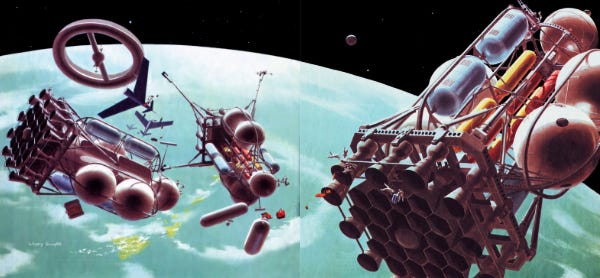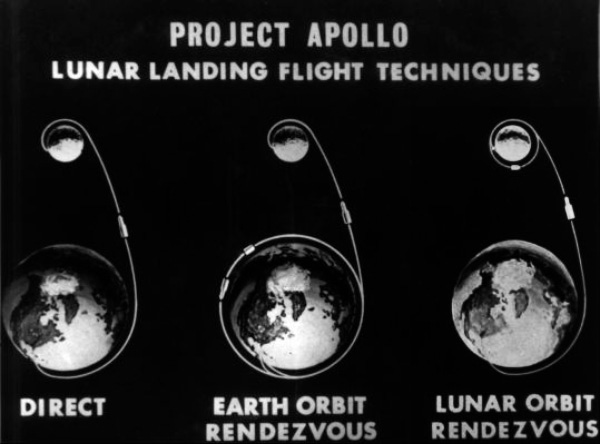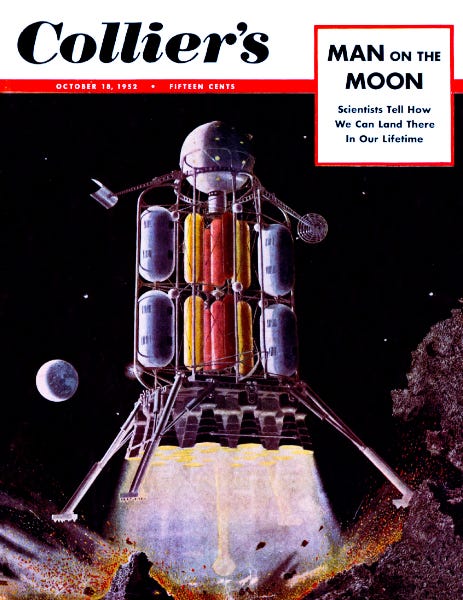The Incredible Shrinking Moon Lander
A giant leap required a small lander
Exploring the intersection of spaceflight history, pop culture, and space art.
Welcome back to Creating Space, and greetings to new subscribers. In total, the list now numbers over fifty, and I am thrilled that you’ve chosen to come along on this ride. This month I continue the theme of early lunar landing spacecraft design. I show you a rare contractor model of a 1962 Lunar Excursion Module concept. I trace how the thinking about how to land on the Moon evolved from the 1940s to the early 1960s. And, I share my rendering of a 1962 Lunar Excursion Module design on the Moon in the style of some of the concept artwork of the time.
Are you new to Creating Space? It’s the NERDSletter that explores the intersection of spaceflight history, pop culture, and space art. You can find this and all other posts at creating-space.art.
Model of the Month
This is one of the rarest space concept models in my collection. I know of only two others like it. It is, as best my research tells, the second iteration of NASA’s original 1962 concept for a lunar landing craft. The model came with its companion Command and Service Modules (shown in the second image).
From what I have read, this lunar lander configuration was conceived by engineers at NASA’s Space Task Group in the year after it was folded into the Manned Spacecraft Center in Houston, Texas. The first iteration lacked the bubble canopy and, instead, had windows that were flush with the conical upper ascent stage.
This early configuration was characterized by its conically shaped upper stage and by having just one engine to perform both the landing and lunar take-off. The lower stage had a central hole through which the engine would be fired. It held the fuel and oxidizer tanks for descent. The upper stage contained the ascent engine and propulsion fluids as well as systems for life support, navigation, control, and two astronauts.
Not depicted on the model is any way for the astronauts to exit the lander to walk on the lunar surface once a successful landing was achieved. One might be led to believe that the astronauts would be limited to sightseeing through the canopy before taking off to join back with the mother ship in lunar orbit. However, other engineering sketches and models show a side hatch. But, as was typical with these early concepts, there was no ladder, so presumably a rope of some kind was to be used to climb down to the surface, and then back up again. Not an easy task for astronauts wearing bulky space suits and carrying equipment and Moon rocks.
According to the auction description which accompanied it, the model was made by the Manned Spacecraft Center Technical Services model shop. Pictured here is the master modeler holding the combined model of the lunar lander and orbital modules posing with several other Technical Services employees.

From Science Fiction to Engineering Reality
The story of how men first got to the Moon features three essential parts that had to come together in perfect harmony – the spacecraft, the rocket, and the mission mode. Let’s look at each part and see how each one’s development depended upon the others.
Thinking Big
Since before Alan Shepard made his historic 15-minute Mercury flight atop a modified Redstone missile in 1961, NASA had been working on plans to send astronauts to the Moon using a much larger rocket.
Initially, the prevailing opinion among rocket scientists at the time was that the way to get to the Moon was by sending a single spacecraft directly from the Earth to the Moon, turning it around tail-first once it arrived, and using its rocket engine to back it down toward the surface until it came gently to rest upon its built-in legs.
I think there is little doubt that science fiction movies of the 1950s had some influence on their thinking. Take a look at Chesley Bonestell’s depiction of just such a Moon rocket. Beautiful, isn’t it? Now, note its huge size in comparison to the tiny astronauts on the surface.

Many questions arise for me. How would the astronauts land such a huge thing backwards? How would they see where they were going? Would the rocket tip over on the uneven ground? How would they get out of the rocket and onto the lunar surface, assuming they landed safely? To me, all this seems quite impractical, but this idea from science fiction was in the consciousness of both the general population and the rocket scientists of the time.
One famed rocket scientist originally from Germany, named Wernher von Braun, had a slightly different idea – although perhaps equally as fantastical. In the early 1950s, von Braun proposed to assemble not one, but three giant purpose-built moonships in Earth orbit before sending them and their fifty-person crew to the Moon. That’s right – fifty scientists and technicians! Von Braun had the foresight to know that a spacecraft that was built to exist only in the vacuum of space need not be streamlined. This idea would later be put into practice in the final design of the Apollo Lunar Module.

Von Braun was so confident in his plan that he, together with other scientists and publisher Cornelius Ryan, introduced the concept to the public by way of publishing it in the popular Collier’s magazine in October 1952. The eight-issue series ran between 1952 and 1954 and featured color illustrations by artists Chesley Bonestell, Fred Freeman, and Rolf Klep.
There is so much more to be said about the Collier’s manned space exploration articles – too much to include here. But, I’ll likely come back to them in future posts.
When the time came to actually design a realistic working lander for the Apollo program, the big-rocket-tail-first landing approach was firmly entrenched in the minds of many engineers. The original design for the Apollo Command and Service modules were conceived with landing on the Moon in mind. For instance, the main Service Propulsion System was sized to have enough power to lift off from the lunar surface (after landing) and enter orbit around the Moon before lighting once more to leave orbit and return home to Earth. Below the Service Module would be a breaking stage to slow the spacecraft for entering lunar orbit and to bring the spacecraft down close to the surface, then be discarded before touchdown. A separate landing stage would contain engines to control the final descent and deployable legs for landing.1
This concept was discarded long before I was old enough to get interested in such things. So, when I first saw illustrations and models of it later in life, I honestly thought they, themselves, were science fiction. Here are several such examples.
We’re Gonna Need a Bigger Rocket
The size of the landing vehicle had a direct influence on the size and lifting capability of the launch vehicle required to get it off the ground. Up until the time of the initial lunar landing mission studies the United States had only launched astronauts on top of two types of rocket boosters. The Redstone short range ballistic missile served to launch the first two Mercury astronauts on suborbital hops followed by several additional Mercury orbital missions launched atop the somewhat more capable Atlas intercontinental ballistic missile (ICBM). In the mid-1960s, the Gemini missions, which had not yet been conceived, would use Titan II ICBMs with even greater orbital lifting capability.
To get men to the Moon a significantly larger and more powerful rocket would need to be developed. Prior to the creation of NASA, the Army Ballistic Missile Agency was studying plans for a large rocket that would use, for its first stage booster, a cluster of existing hardware from the Jupiter and Redstone missiles. NASA, after its inception, inherited and adopted that project and later named it Saturn.

There were three Saturn variants under development known as Saturn C-1, C-3, and the largest being C-5. Saturn C-5 would be renamed Saturn V, which has come to be synonymous with the Apollo Moon program. As enormous as the Saturn C-5 was, it would still take two launches and refueling while in orbit to send the currently planned Apollo spacecraft to the Moon. An even more monstrous rocket would have to be built to take Apollo straight to the Moon in a single launch. That imagined configuration was called Nova.
Here is a conceptual comparison of the giant leap in rocket size going from Atlas and Titan to Saturn and Nova. When I try to put myself in the place of the engineers at the time, it seems almost audacious to seriously believe such a technological advancement could be possible. Yet, that is exactly what they did. It is truly a testament to their ingenuity and capability that they actually built the Saturn V and successfully carried out the lunar landing missions.

As it turns out, NASA management came to realize that neither of these approaches was ideal. Relying upon multiple Saturn launches to be successful was a risky proposition. And orbital refueling had not yet been tried. In addition to the technical risks, NASA’s budget and the schedule set forth by the “end of the decade” goal limited what it could realistically do. Neither building the dozens of Saturn C-5s to cover the entire Apollo program, nor developing and building the huge Nova were within NASA’s immediate means.
’Tain’t What You Do (It's the Way That Cha Do It)
It didn’t take long for the engineers and scientists responsible for building the launch vehicle that would have to lift such a massive spacecraft off the launch pad and send it to the Moon to accept that they needed to figure out a better way.
Lunar Orbit Rendezvous was the name given for what was determined to be that better way. LOR, as it was abbreviated, meant that two spacecraft would be sent to the Moon and only the smaller one would need to land. The second vehicle, with its heavy heatshield for Earth reentry, propulsion systems, and life support equipment for a seven day round trip, could stay in orbit around the Moon. Once the astronauts had completed their exploration on the surface, the lander would lift off and rendezvous back with the mother ship in lunar orbit. This was the birth of the concept of the Lunar Excursion Module (LEM).
Using a smaller lander together with a more streamlined Command and Service Module meant that a single Saturn C-5 would be capable of performing the mission.
In July of 1962, NASA presented to the press a summary of the engineering studies that had been carried out by the major NASA centers during the prior months. They described three main modes of accomplishing a manned lunar landing mission by the end of the decade: Direct Ascent, Earth Orbit Rendezvous, and Lunar Orbit Rendezvous.2

Two of the mission modes involved landing the massive Apollo Command and Service modules (already in development at North American Aviation) backwards onto the lunar surface, Chesley Bonestell style, as discussed earlier. The third mission mode, Lunar Orbit Rendezvous, would use the relatively diminutive LEM.
The choice to use a specialized lunar lander must have become obvious to the observers when they were shown models comparing the two competing spacecraft configurations side-by-side.

The Lunar Orbit Rendezvous mode was selected and NASA called upon the U.S. aviation and aerospace companies to submit proposals for the LEM. Grumman Aircraft Engineering Corporation in Bethpage, New York, ultimately won the contract with their design.
Space Art of the Month
The Way It Was Imagined: 1962 LEM
As the Apollo program was beginning to take shape in the early 1960s, NASA engineers were working to decide among three different methods of landing astronauts on the Moon. The mode called Lunar Orbit Rendezvous was chosen. That meant an entirely new kind of spacecraft had to be developed – one that was specifically designed to land on the Moon, then lift off from the surface and rendezvous with a mother ship in lunar orbit.
Spacecraft designers at NASA's newly-formed Manned Spacecraft Center worked through several designs in the evolution of the Apollo Lunar Excursion Module (LEM). This image depicts one of the earliest LEM designs from 1962. It is shown just after landing on the Moon as it might have been imagined by artists of the time.
My space-inspired art portfolio can be found at pixel-planet-pictures.com.
Do you know fellow Space Geeks who might enjoy Creating Space? Invite them into this space, too!
Did you miss a post? Catch up here.
If you enjoyed this article please hit the ‘Like’ button and feel free to comment.
All images and text copyright © Dave Ginsberg, unless otherwise noted. All rights reserved.
Lunar Orbit Rendezvous News Conference, NASA













What a treasure trove of information about early space exploration! Thank you!
Episode 5, "Spider", of HBO's 1998 'From the Earth to the Moon' is all about the engineering of the lunar module.
The Saturn V weighed about 6 ½ million pounds at liftoff, and these guys were trying to shave every ounce they could off of the lander.
For some reason, that made 'Spider' my favorite episode of the series.